Fever: Development, Benefits and Management of Staphylococcus aureus Infection
VerifiedAdded on 2019/11/25
|5
|1821
|419
Report
AI Summary
The assignment discusses the case of Mary who has an infected wound caused by Staphylococcus aureus bacteria. The pathogenic bacteria release endotoxins that trigger a febrile response, leading to fever. Fever is beneficial as it protects against pathogens and lowers mineral concentrations in the serum, making it harder for them to multiply. Staphylococcus aureus can be transmitted through endogenous sources such as nasal carriage and exogenous sources like contaminated hands of healthcare workers. Augmentin, a combination of Amoxycillin and clavulenic acid, is prescribed to Mary due to its effectiveness against resistant S. aureus strains.
Contribute Materials
Your contribution can guide someone’s learning journey. Share your
documents today.
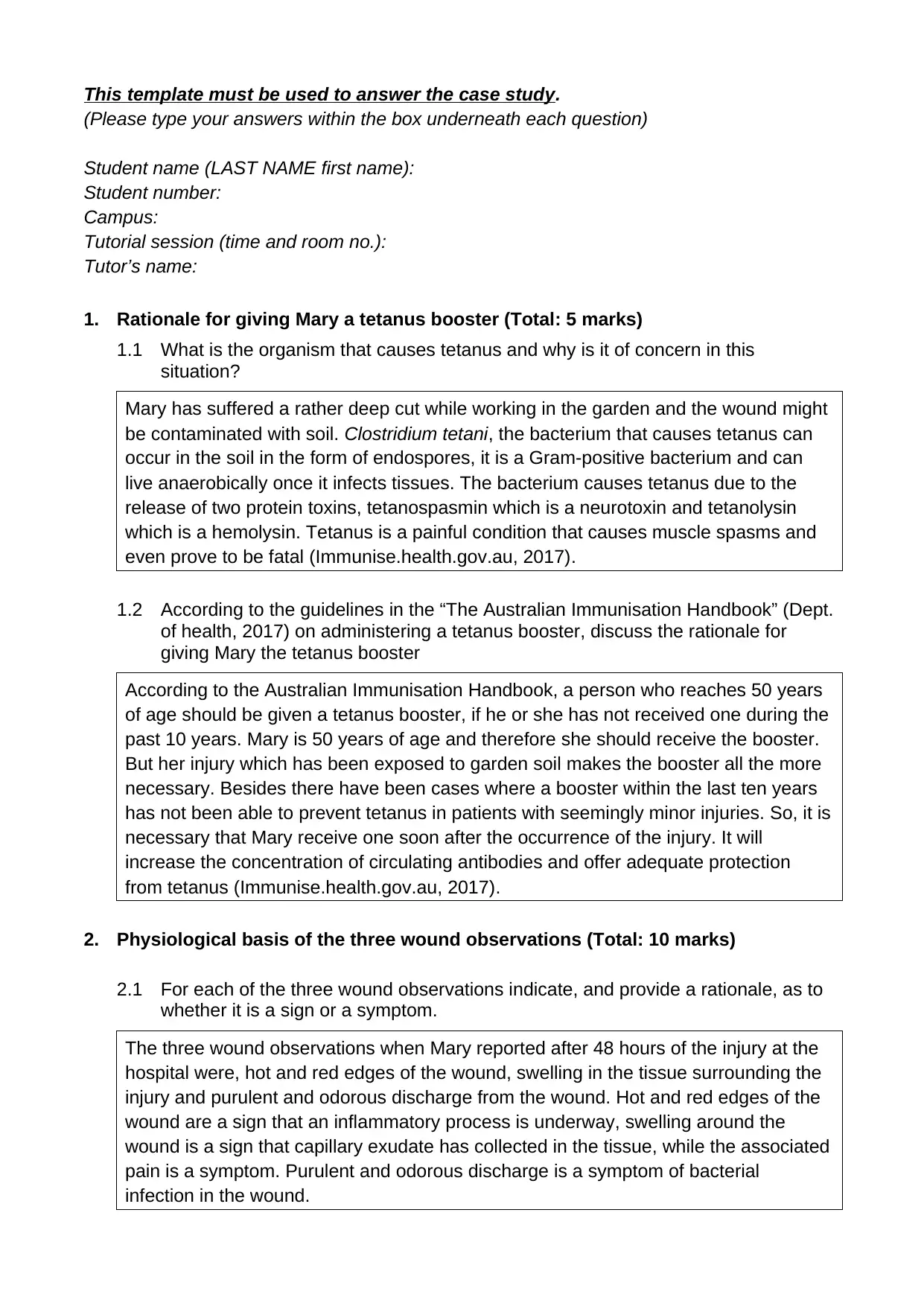
This template must be used to answer the case study.
(Please type your answers within the box underneath each question)
Student name (LAST NAME first name):
Student number:
Campus:
Tutorial session (time and room no.):
Tutor’s name:
1. Rationale for giving Mary a tetanus booster (Total: 5 marks)
1.1 What is the organism that causes tetanus and why is it of concern in this
situation?
Mary has suffered a rather deep cut while working in the garden and the wound might
be contaminated with soil. Clostridium tetani, the bacterium that causes tetanus can
occur in the soil in the form of endospores, it is a Gram-positive bacterium and can
live anaerobically once it infects tissues. The bacterium causes tetanus due to the
release of two protein toxins, tetanospasmin which is a neurotoxin and tetanolysin
which is a hemolysin. Tetanus is a painful condition that causes muscle spasms and
even prove to be fatal (Immunise.health.gov.au, 2017).
1.2 According to the guidelines in the “The Australian Immunisation Handbook” (Dept.
of health, 2017) on administering a tetanus booster, discuss the rationale for
giving Mary the tetanus booster
According to the Australian Immunisation Handbook, a person who reaches 50 years
of age should be given a tetanus booster, if he or she has not received one during the
past 10 years. Mary is 50 years of age and therefore she should receive the booster.
But her injury which has been exposed to garden soil makes the booster all the more
necessary. Besides there have been cases where a booster within the last ten years
has not been able to prevent tetanus in patients with seemingly minor injuries. So, it is
necessary that Mary receive one soon after the occurrence of the injury. It will
increase the concentration of circulating antibodies and offer adequate protection
from tetanus (Immunise.health.gov.au, 2017).
2. Physiological basis of the three wound observations (Total: 10 marks)
2.1 For each of the three wound observations indicate, and provide a rationale, as to
whether it is a sign or a symptom.
The three wound observations when Mary reported after 48 hours of the injury at the
hospital were, hot and red edges of the wound, swelling in the tissue surrounding the
injury and purulent and odorous discharge from the wound. Hot and red edges of the
wound are a sign that an inflammatory process is underway, swelling around the
wound is a sign that capillary exudate has collected in the tissue, while the associated
pain is a symptom. Purulent and odorous discharge is a symptom of bacterial
infection in the wound.
(Please type your answers within the box underneath each question)
Student name (LAST NAME first name):
Student number:
Campus:
Tutorial session (time and room no.):
Tutor’s name:
1. Rationale for giving Mary a tetanus booster (Total: 5 marks)
1.1 What is the organism that causes tetanus and why is it of concern in this
situation?
Mary has suffered a rather deep cut while working in the garden and the wound might
be contaminated with soil. Clostridium tetani, the bacterium that causes tetanus can
occur in the soil in the form of endospores, it is a Gram-positive bacterium and can
live anaerobically once it infects tissues. The bacterium causes tetanus due to the
release of two protein toxins, tetanospasmin which is a neurotoxin and tetanolysin
which is a hemolysin. Tetanus is a painful condition that causes muscle spasms and
even prove to be fatal (Immunise.health.gov.au, 2017).
1.2 According to the guidelines in the “The Australian Immunisation Handbook” (Dept.
of health, 2017) on administering a tetanus booster, discuss the rationale for
giving Mary the tetanus booster
According to the Australian Immunisation Handbook, a person who reaches 50 years
of age should be given a tetanus booster, if he or she has not received one during the
past 10 years. Mary is 50 years of age and therefore she should receive the booster.
But her injury which has been exposed to garden soil makes the booster all the more
necessary. Besides there have been cases where a booster within the last ten years
has not been able to prevent tetanus in patients with seemingly minor injuries. So, it is
necessary that Mary receive one soon after the occurrence of the injury. It will
increase the concentration of circulating antibodies and offer adequate protection
from tetanus (Immunise.health.gov.au, 2017).
2. Physiological basis of the three wound observations (Total: 10 marks)
2.1 For each of the three wound observations indicate, and provide a rationale, as to
whether it is a sign or a symptom.
The three wound observations when Mary reported after 48 hours of the injury at the
hospital were, hot and red edges of the wound, swelling in the tissue surrounding the
injury and purulent and odorous discharge from the wound. Hot and red edges of the
wound are a sign that an inflammatory process is underway, swelling around the
wound is a sign that capillary exudate has collected in the tissue, while the associated
pain is a symptom. Purulent and odorous discharge is a symptom of bacterial
infection in the wound.
Secure Best Marks with AI Grader
Need help grading? Try our AI Grader for instant feedback on your assignments.
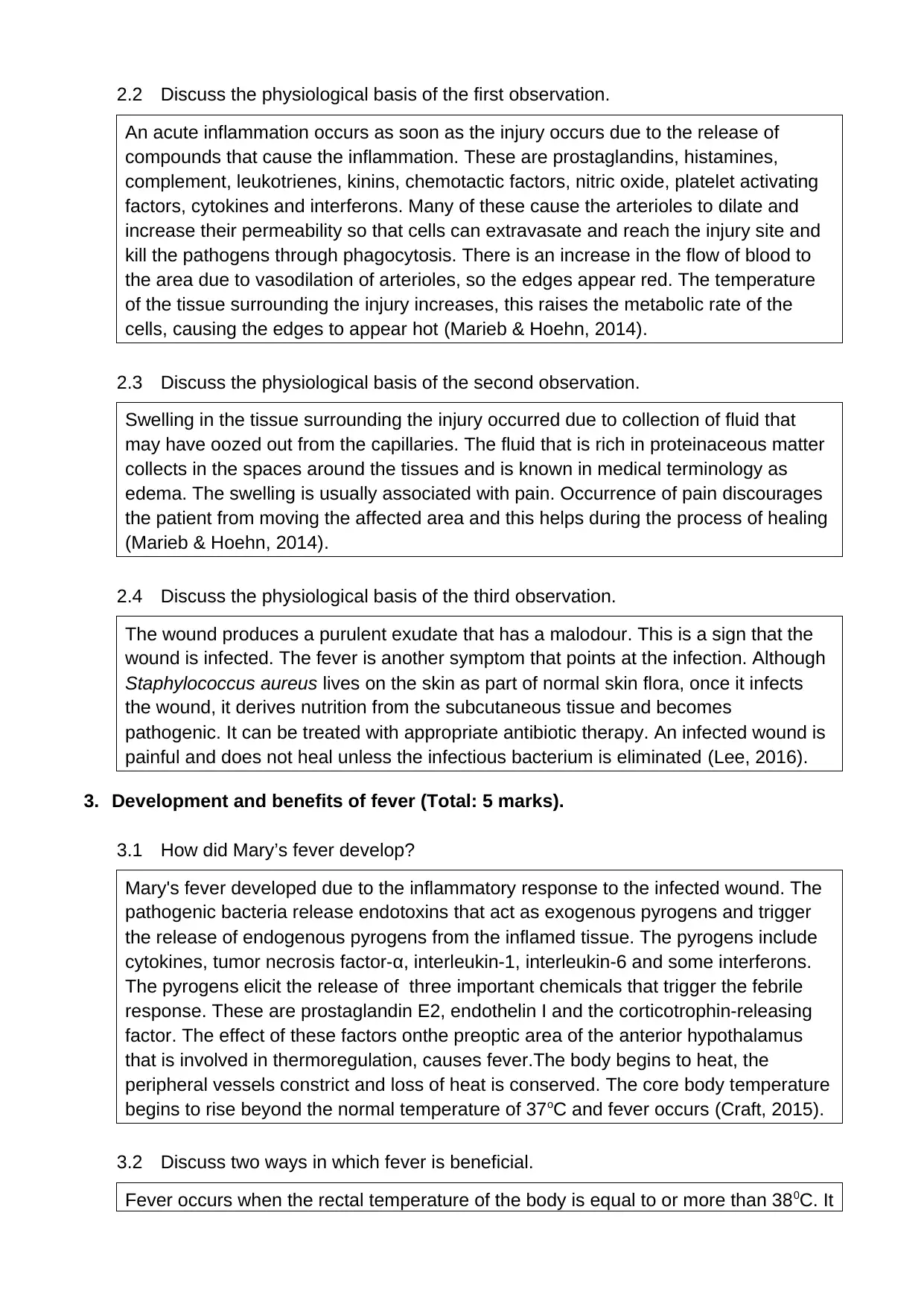
2.2 Discuss the physiological basis of the first observation.
An acute inflammation occurs as soon as the injury occurs due to the release of
compounds that cause the inflammation. These are prostaglandins, histamines,
complement, leukotrienes, kinins, chemotactic factors, nitric oxide, platelet activating
factors, cytokines and interferons. Many of these cause the arterioles to dilate and
increase their permeability so that cells can extravasate and reach the injury site and
kill the pathogens through phagocytosis. There is an increase in the flow of blood to
the area due to vasodilation of arterioles, so the edges appear red. The temperature
of the tissue surrounding the injury increases, this raises the metabolic rate of the
cells, causing the edges to appear hot (Marieb & Hoehn, 2014).
2.3 Discuss the physiological basis of the second observation.
Swelling in the tissue surrounding the injury occurred due to collection of fluid that
may have oozed out from the capillaries. The fluid that is rich in proteinaceous matter
collects in the spaces around the tissues and is known in medical terminology as
edema. The swelling is usually associated with pain. Occurrence of pain discourages
the patient from moving the affected area and this helps during the process of healing
(Marieb & Hoehn, 2014).
2.4 Discuss the physiological basis of the third observation.
The wound produces a purulent exudate that has a malodour. This is a sign that the
wound is infected. The fever is another symptom that points at the infection. Although
Staphylococcus aureus lives on the skin as part of normal skin flora, once it infects
the wound, it derives nutrition from the subcutaneous tissue and becomes
pathogenic. It can be treated with appropriate antibiotic therapy. An infected wound is
painful and does not heal unless the infectious bacterium is eliminated (Lee, 2016).
3. Development and benefits of fever (Total: 5 marks).
3.1 How did Mary’s fever develop?
Mary's fever developed due to the inflammatory response to the infected wound. The
pathogenic bacteria release endotoxins that act as exogenous pyrogens and trigger
the release of endogenous pyrogens from the inflamed tissue. The pyrogens include
cytokines, tumor necrosis factor-α, interleukin-1, interleukin-6 and some interferons.
The pyrogens elicit the release of three important chemicals that trigger the febrile
response. These are prostaglandin E2, endothelin I and the corticotrophin-releasing
factor. The effect of these factors onthe preoptic area of the anterior hypothalamus
that is involved in thermoregulation, causes fever.The body begins to heat, the
peripheral vessels constrict and loss of heat is conserved. The core body temperature
begins to rise beyond the normal temperature of 37oC and fever occurs (Craft, 2015).
3.2 Discuss two ways in which fever is beneficial.
Fever occurs when the rectal temperature of the body is equal to or more than 380C. It
An acute inflammation occurs as soon as the injury occurs due to the release of
compounds that cause the inflammation. These are prostaglandins, histamines,
complement, leukotrienes, kinins, chemotactic factors, nitric oxide, platelet activating
factors, cytokines and interferons. Many of these cause the arterioles to dilate and
increase their permeability so that cells can extravasate and reach the injury site and
kill the pathogens through phagocytosis. There is an increase in the flow of blood to
the area due to vasodilation of arterioles, so the edges appear red. The temperature
of the tissue surrounding the injury increases, this raises the metabolic rate of the
cells, causing the edges to appear hot (Marieb & Hoehn, 2014).
2.3 Discuss the physiological basis of the second observation.
Swelling in the tissue surrounding the injury occurred due to collection of fluid that
may have oozed out from the capillaries. The fluid that is rich in proteinaceous matter
collects in the spaces around the tissues and is known in medical terminology as
edema. The swelling is usually associated with pain. Occurrence of pain discourages
the patient from moving the affected area and this helps during the process of healing
(Marieb & Hoehn, 2014).
2.4 Discuss the physiological basis of the third observation.
The wound produces a purulent exudate that has a malodour. This is a sign that the
wound is infected. The fever is another symptom that points at the infection. Although
Staphylococcus aureus lives on the skin as part of normal skin flora, once it infects
the wound, it derives nutrition from the subcutaneous tissue and becomes
pathogenic. It can be treated with appropriate antibiotic therapy. An infected wound is
painful and does not heal unless the infectious bacterium is eliminated (Lee, 2016).
3. Development and benefits of fever (Total: 5 marks).
3.1 How did Mary’s fever develop?
Mary's fever developed due to the inflammatory response to the infected wound. The
pathogenic bacteria release endotoxins that act as exogenous pyrogens and trigger
the release of endogenous pyrogens from the inflamed tissue. The pyrogens include
cytokines, tumor necrosis factor-α, interleukin-1, interleukin-6 and some interferons.
The pyrogens elicit the release of three important chemicals that trigger the febrile
response. These are prostaglandin E2, endothelin I and the corticotrophin-releasing
factor. The effect of these factors onthe preoptic area of the anterior hypothalamus
that is involved in thermoregulation, causes fever.The body begins to heat, the
peripheral vessels constrict and loss of heat is conserved. The core body temperature
begins to rise beyond the normal temperature of 37oC and fever occurs (Craft, 2015).
3.2 Discuss two ways in which fever is beneficial.
Fever occurs when the rectal temperature of the body is equal to or more than 380C. It
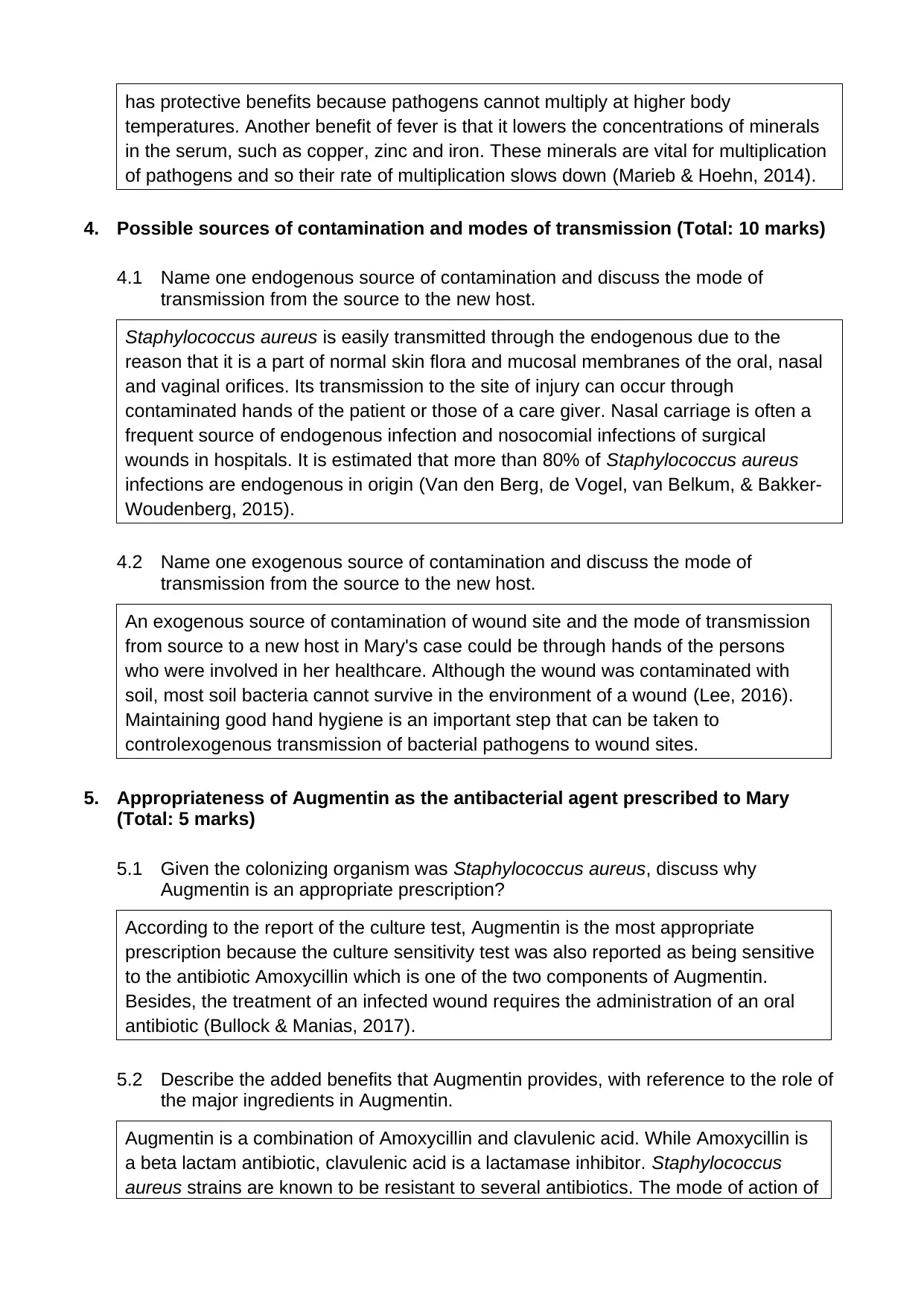
has protective benefits because pathogens cannot multiply at higher body
temperatures. Another benefit of fever is that it lowers the concentrations of minerals
in the serum, such as copper, zinc and iron. These minerals are vital for multiplication
of pathogens and so their rate of multiplication slows down (Marieb & Hoehn, 2014).
4. Possible sources of contamination and modes of transmission (Total: 10 marks)
4.1 Name one endogenous source of contamination and discuss the mode of
transmission from the source to the new host.
Staphylococcus aureus is easily transmitted through the endogenous due to the
reason that it is a part of normal skin flora and mucosal membranes of the oral, nasal
and vaginal orifices. Its transmission to the site of injury can occur through
contaminated hands of the patient or those of a care giver. Nasal carriage is often a
frequent source of endogenous infection and nosocomial infections of surgical
wounds in hospitals. It is estimated that more than 80% of Staphylococcus aureus
infections are endogenous in origin (Van den Berg, de Vogel, van Belkum, & Bakker-
Woudenberg, 2015).
4.2 Name one exogenous source of contamination and discuss the mode of
transmission from the source to the new host.
An exogenous source of contamination of wound site and the mode of transmission
from source to a new host in Mary's case could be through hands of the persons
who were involved in her healthcare. Although the wound was contaminated with
soil, most soil bacteria cannot survive in the environment of a wound (Lee, 2016).
Maintaining good hand hygiene is an important step that can be taken to
controlexogenous transmission of bacterial pathogens to wound sites.
5. Appropriateness of Augmentin as the antibacterial agent prescribed to Mary
(Total: 5 marks)
5.1 Given the colonizing organism was Staphylococcus aureus, discuss why
Augmentin is an appropriate prescription?
According to the report of the culture test, Augmentin is the most appropriate
prescription because the culture sensitivity test was also reported as being sensitive
to the antibiotic Amoxycillin which is one of the two components of Augmentin.
Besides, the treatment of an infected wound requires the administration of an oral
antibiotic (Bullock & Manias, 2017).
5.2 Describe the added benefits that Augmentin provides, with reference to the role of
the major ingredients in Augmentin.
Augmentin is a combination of Amoxycillin and clavulenic acid. While Amoxycillin is
a beta lactam antibiotic, clavulenic acid is a lactamase inhibitor. Staphylococcus
aureus strains are known to be resistant to several antibiotics. The mode of action of
temperatures. Another benefit of fever is that it lowers the concentrations of minerals
in the serum, such as copper, zinc and iron. These minerals are vital for multiplication
of pathogens and so their rate of multiplication slows down (Marieb & Hoehn, 2014).
4. Possible sources of contamination and modes of transmission (Total: 10 marks)
4.1 Name one endogenous source of contamination and discuss the mode of
transmission from the source to the new host.
Staphylococcus aureus is easily transmitted through the endogenous due to the
reason that it is a part of normal skin flora and mucosal membranes of the oral, nasal
and vaginal orifices. Its transmission to the site of injury can occur through
contaminated hands of the patient or those of a care giver. Nasal carriage is often a
frequent source of endogenous infection and nosocomial infections of surgical
wounds in hospitals. It is estimated that more than 80% of Staphylococcus aureus
infections are endogenous in origin (Van den Berg, de Vogel, van Belkum, & Bakker-
Woudenberg, 2015).
4.2 Name one exogenous source of contamination and discuss the mode of
transmission from the source to the new host.
An exogenous source of contamination of wound site and the mode of transmission
from source to a new host in Mary's case could be through hands of the persons
who were involved in her healthcare. Although the wound was contaminated with
soil, most soil bacteria cannot survive in the environment of a wound (Lee, 2016).
Maintaining good hand hygiene is an important step that can be taken to
controlexogenous transmission of bacterial pathogens to wound sites.
5. Appropriateness of Augmentin as the antibacterial agent prescribed to Mary
(Total: 5 marks)
5.1 Given the colonizing organism was Staphylococcus aureus, discuss why
Augmentin is an appropriate prescription?
According to the report of the culture test, Augmentin is the most appropriate
prescription because the culture sensitivity test was also reported as being sensitive
to the antibiotic Amoxycillin which is one of the two components of Augmentin.
Besides, the treatment of an infected wound requires the administration of an oral
antibiotic (Bullock & Manias, 2017).
5.2 Describe the added benefits that Augmentin provides, with reference to the role of
the major ingredients in Augmentin.
Augmentin is a combination of Amoxycillin and clavulenic acid. While Amoxycillin is
a beta lactam antibiotic, clavulenic acid is a lactamase inhibitor. Staphylococcus
aureus strains are known to be resistant to several antibiotics. The mode of action of
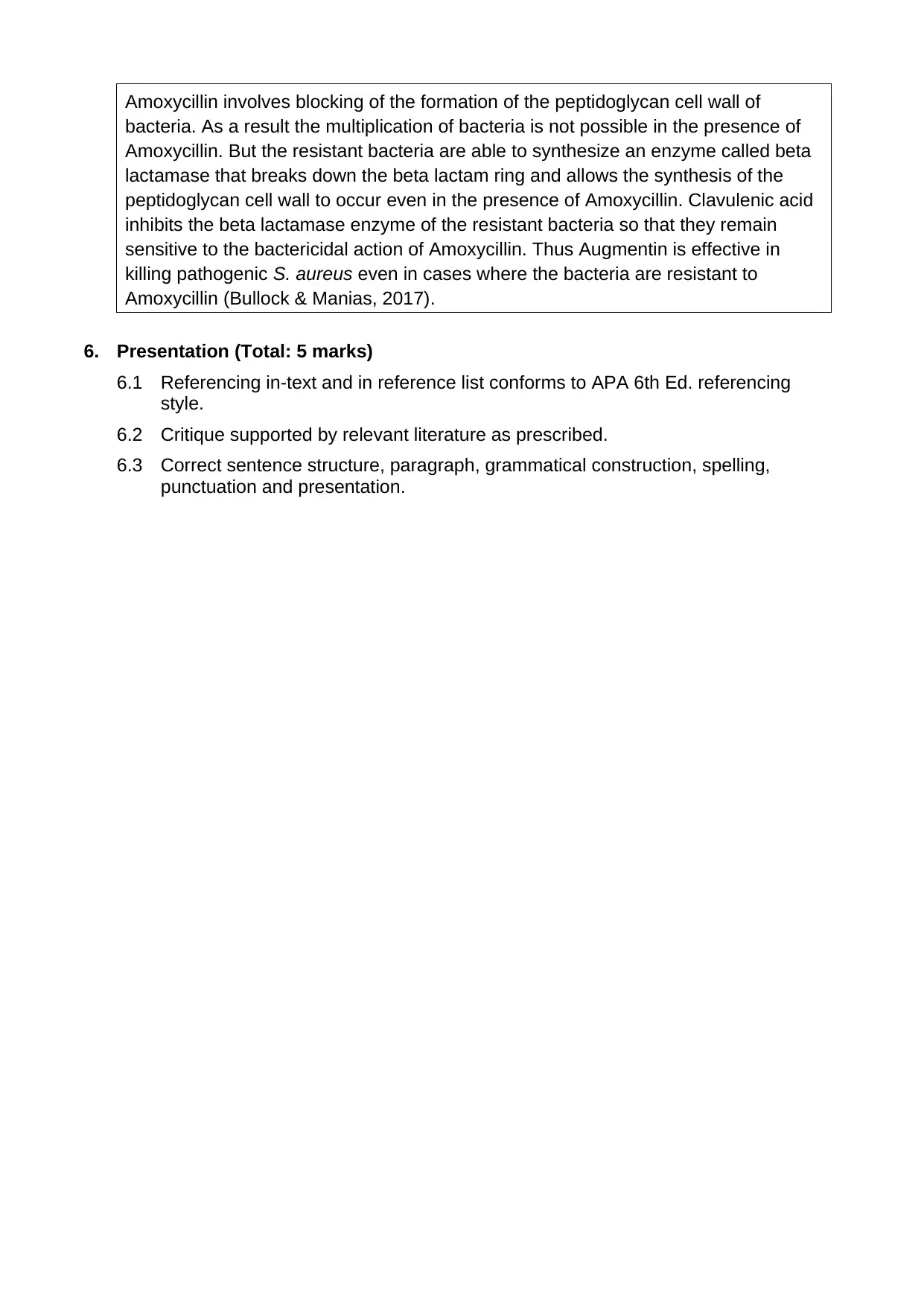
Amoxycillin involves blocking of the formation of the peptidoglycan cell wall of
bacteria. As a result the multiplication of bacteria is not possible in the presence of
Amoxycillin. But the resistant bacteria are able to synthesize an enzyme called beta
lactamase that breaks down the beta lactam ring and allows the synthesis of the
peptidoglycan cell wall to occur even in the presence of Amoxycillin. Clavulenic acid
inhibits the beta lactamase enzyme of the resistant bacteria so that they remain
sensitive to the bactericidal action of Amoxycillin. Thus Augmentin is effective in
killing pathogenic S. aureus even in cases where the bacteria are resistant to
Amoxycillin (Bullock & Manias, 2017).
6. Presentation (Total: 5 marks)
6.1 Referencing in-text and in reference list conforms to APA 6th Ed. referencing
style.
6.2 Critique supported by relevant literature as prescribed.
6.3 Correct sentence structure, paragraph, grammatical construction, spelling,
punctuation and presentation.
bacteria. As a result the multiplication of bacteria is not possible in the presence of
Amoxycillin. But the resistant bacteria are able to synthesize an enzyme called beta
lactamase that breaks down the beta lactam ring and allows the synthesis of the
peptidoglycan cell wall to occur even in the presence of Amoxycillin. Clavulenic acid
inhibits the beta lactamase enzyme of the resistant bacteria so that they remain
sensitive to the bactericidal action of Amoxycillin. Thus Augmentin is effective in
killing pathogenic S. aureus even in cases where the bacteria are resistant to
Amoxycillin (Bullock & Manias, 2017).
6. Presentation (Total: 5 marks)
6.1 Referencing in-text and in reference list conforms to APA 6th Ed. referencing
style.
6.2 Critique supported by relevant literature as prescribed.
6.3 Correct sentence structure, paragraph, grammatical construction, spelling,
punctuation and presentation.
Secure Best Marks with AI Grader
Need help grading? Try our AI Grader for instant feedback on your assignments.
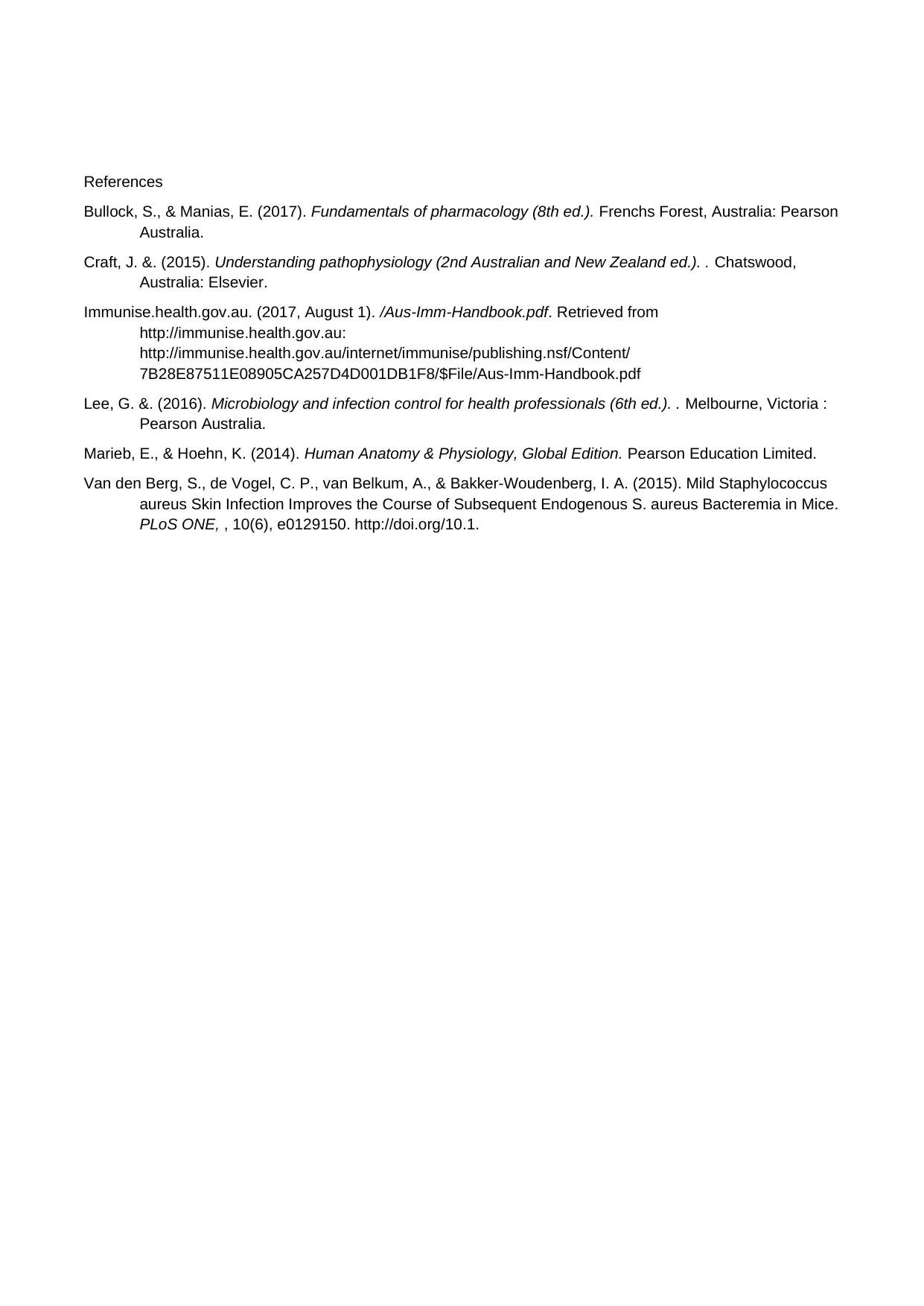
References
Bullock, S., & Manias, E. (2017). Fundamentals of pharmacology (8th ed.). Frenchs Forest, Australia: Pearson
Australia.
Craft, J. &. (2015). Understanding pathophysiology (2nd Australian and New Zealand ed.). . Chatswood,
Australia: Elsevier.
Immunise.health.gov.au. (2017, August 1). /Aus-Imm-Handbook.pdf. Retrieved from
http://immunise.health.gov.au:
http://immunise.health.gov.au/internet/immunise/publishing.nsf/Content/
7B28E87511E08905CA257D4D001DB1F8/$File/Aus-Imm-Handbook.pdf
Lee, G. &. (2016). Microbiology and infection control for health professionals (6th ed.). . Melbourne, Victoria :
Pearson Australia.
Marieb, E., & Hoehn, K. (2014). Human Anatomy & Physiology, Global Edition. Pearson Education Limited.
Van den Berg, S., de Vogel, C. P., van Belkum, A., & Bakker-Woudenberg, I. A. (2015). Mild Staphylococcus
aureus Skin Infection Improves the Course of Subsequent Endogenous S. aureus Bacteremia in Mice.
PLoS ONE, , 10(6), e0129150. http://doi.org/10.1.
Bullock, S., & Manias, E. (2017). Fundamentals of pharmacology (8th ed.). Frenchs Forest, Australia: Pearson
Australia.
Craft, J. &. (2015). Understanding pathophysiology (2nd Australian and New Zealand ed.). . Chatswood,
Australia: Elsevier.
Immunise.health.gov.au. (2017, August 1). /Aus-Imm-Handbook.pdf. Retrieved from
http://immunise.health.gov.au:
http://immunise.health.gov.au/internet/immunise/publishing.nsf/Content/
7B28E87511E08905CA257D4D001DB1F8/$File/Aus-Imm-Handbook.pdf
Lee, G. &. (2016). Microbiology and infection control for health professionals (6th ed.). . Melbourne, Victoria :
Pearson Australia.
Marieb, E., & Hoehn, K. (2014). Human Anatomy & Physiology, Global Edition. Pearson Education Limited.
Van den Berg, S., de Vogel, C. P., van Belkum, A., & Bakker-Woudenberg, I. A. (2015). Mild Staphylococcus
aureus Skin Infection Improves the Course of Subsequent Endogenous S. aureus Bacteremia in Mice.
PLoS ONE, , 10(6), e0129150. http://doi.org/10.1.
1 out of 5
Related Documents
Your All-in-One AI-Powered Toolkit for Academic Success.
+13062052269
info@desklib.com
Available 24*7 on WhatsApp / Email
![[object Object]](/_next/static/media/star-bottom.7253800d.svg)
Unlock your academic potential
© 2024 | Zucol Services PVT LTD | All rights reserved.





